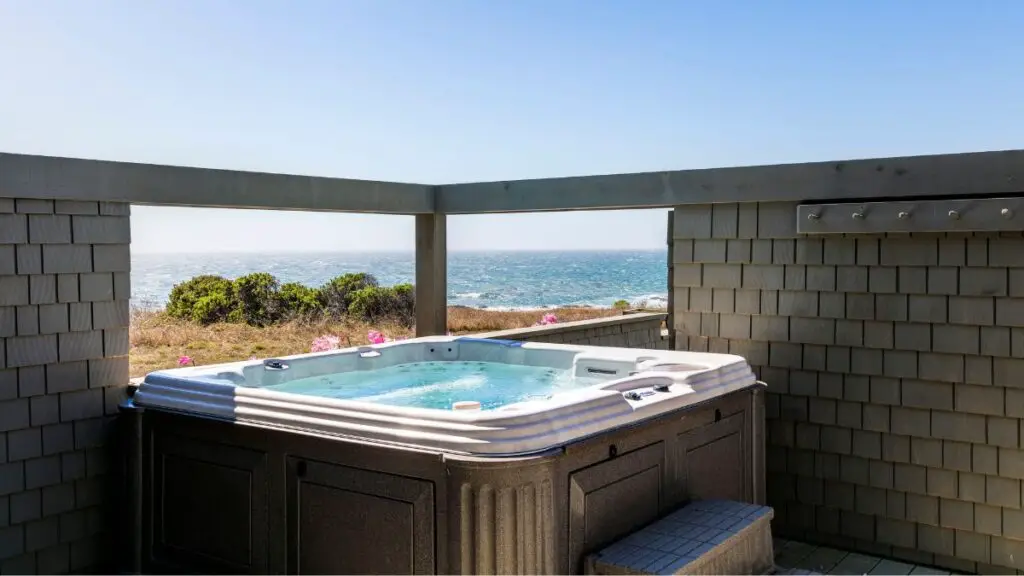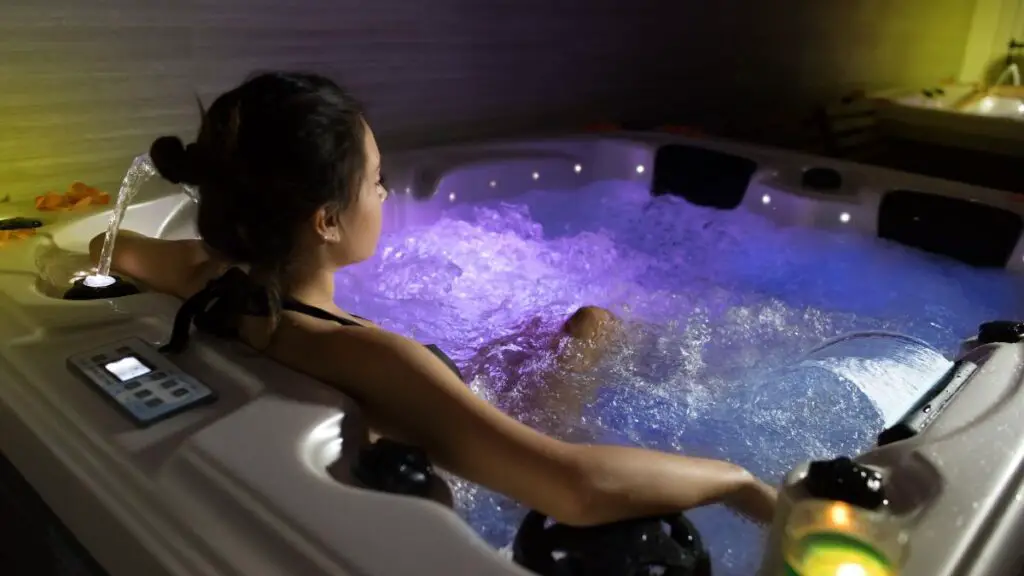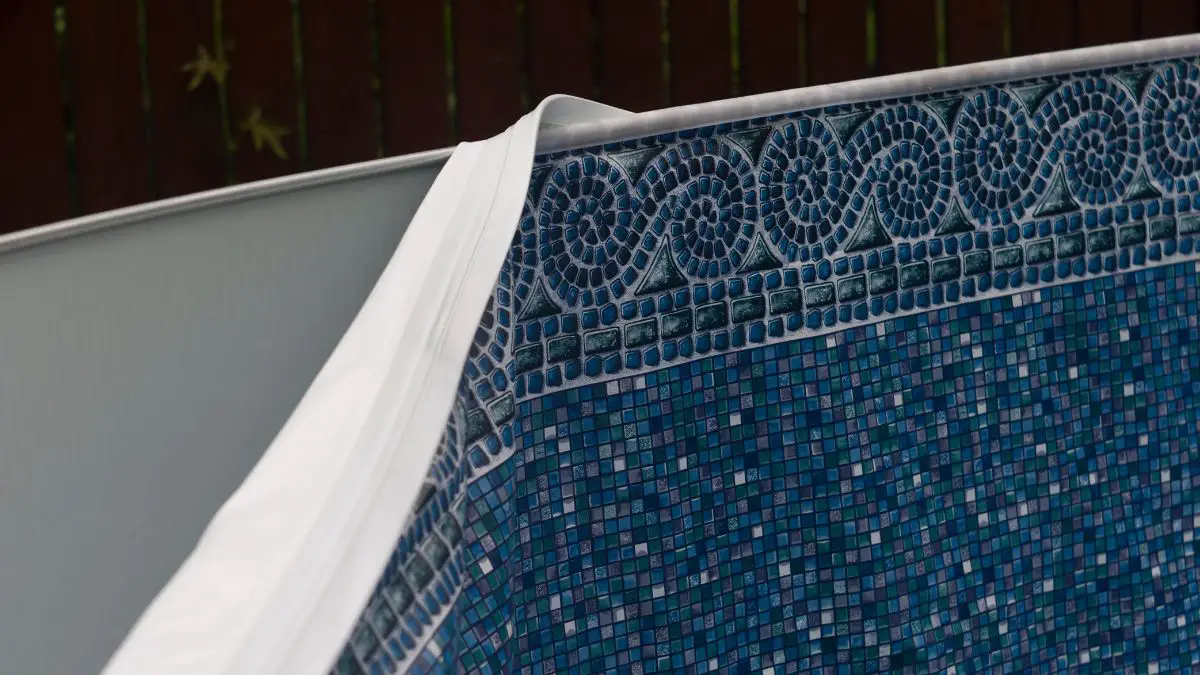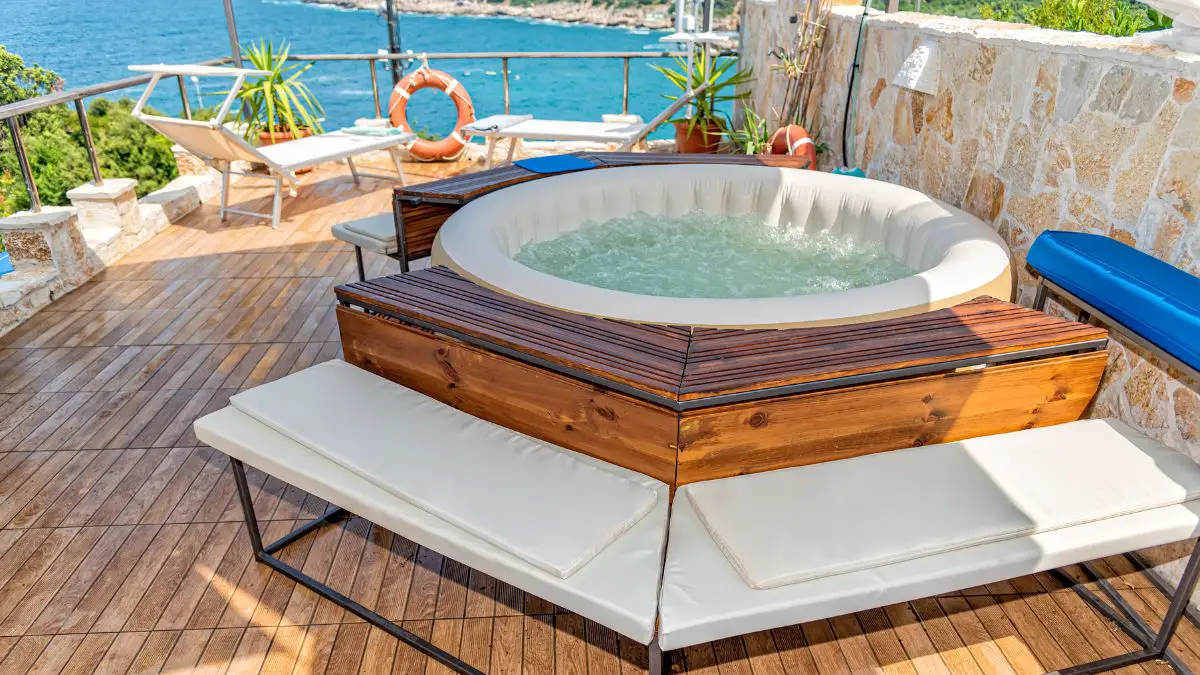When it comes to your hot tub temperature, aim for a range between 100°F and 102°F for the ideal balance of comfort and safety. Remember, personal preference and health considerations can influence this but never exceed the maximum safe limit of 104°F
Moreover, did you know that the temperature of your hot tub can impact its energy consumption? Yes, that’s right. A hot tub always cranked to the maximum temperature can consume more energy, leading to higher utility bills.
In the following sections, we’ll delve deeper into hot tub temperatures, from the ideal range to safety guidelines and how to maintain it. So, sit back, relax, and turn up the heat on your hot tub knowledge.

The Ideal Hot Tub Temperature
When it comes to the ideal hot tub temperature, there’s a standard range that experts recommend. This range is typically between 100°F and 102°F. However, the maximum water temperature a hot tub should reach is 104°F. Beyond this point, the hot water can become dangerous and pose health risks.
The Standard Temperature Range for Hot Tubs
The standard hot tub temperature range is designed to provide a comfortable and safe soaking experience. Within this range:
- The fresh water is warm enough to help relax your muscles and soothe any aches or pains.
- It’s not so hot that it poses a risk of overheating or dehydration.
Factors Influencing the Ideal Temperature
Several factors can influence what the ideal hot tub temperature is for you. These include:
- Age: Young children and older adults may be more sensitive to higher temperatures. For them, a lower temperature may be more comfortable and safer.
- Health Condition: Certain health conditions, such as heart disease, heart conditions, or high blood pressure, may require a lower hot tub temperature. Always consult with a healthcare professional if you have health concerns.
- Pregnancy: Pregnant women should be particularly cautious with hot tub temperatures. Keeping the temperature at 102°F and limiting soaking time to 10 minutes is generally recommended.
The Role of Personal Preference
While there are guidelines and factors to consider, the ideal hot tub temperature ultimately depends on personal preference. Some people prefer a hotter soak, while others find a slightly cooler temperature more enjoyable.
The goal is to create a relaxing and enjoyable experience. So, adjust the temperature within the safe range to find what’s most comfortable for you. After all, your hot tub is there for your enjoyment and relaxation.

Understanding Hot Tub Temperatures
Diving into hot tub temperatures can feel like a science class. But don’t worry, we’ll make it easy and interesting. Let’s explore the science behind hot tub temperatures, how they affect your experience, and their relationship with energy consumption.
The Science Behind Hot Tub Temperatures
The science of hot tub temperatures revolves around heat transfer. When you step into a hot tub, your body absorbs heat from the water, raising your normal body temperature. This causes your blood vessels to dilate, increasing blood flow and helping to relax your muscles.
However, it’s crucial to maintain a balance. While warm water can be soothing, too high a temperature can cause your body to overheat, leading to dizziness or nausea. That’s why the maximum hot tub temperature is capped at 104°F.
The Effect of Temperature on the Hot Tub Experience
The temperature of your hot tub plays a significant role in shaping your hot tub experience. Here’s how:
- Comfort: The right temperature can make your hot tub experience incredibly comfortable and relaxing. It’s like a warm hug that melts away stress and tension.
- Therapeutic Benefits: Warm water is known for its therapeutic benefits. It can help to relieve muscle tension, soothe aches and pains, and even improve sleep.
- Safety: Maintaining the correct temperature is crucial for safety. A too-hot tub can lead to overheating, while a too-cold tub may not provide the desired benefits.
Hot Tub Temperature and Energy Consumption
You might wonder how hot a hot tub can go without skyrocketing your energy bill. The truth is the temperature of your hot tub can significantly impact its energy consumption.
- Higher temperatures require more energy to maintain, leading to higher energy costs.
- Lower temperatures, while more energy-efficient, may not provide the warmth and comfort you desire.
A temperature between 100°F and 102°F is generally considered ideal, providing a comfortable soak without excessive energy use.

Safety Guidelines for Hot Tub Temperatures
When it comes to enjoying your hot tub, safety should always be a top priority. This includes understanding the maximum safe temperature for hot tubs, being aware of the risks associated with high temperatures, and taking special precautions for different groups.
The Maximum Safe Temperature for Hot Tubs
Safety guidelines say the maximum hot tub temperature should not exceed 104°F. This temperature limit is set to prevent overheating and the potential health risks that come with it. Remember, a hot tub is meant to be a place of relaxation, not a danger to your health.
Risks Associated with High Hot Tub Temperatures
While a warm soak can be incredibly relaxing, hot tub temperatures that are too high can pose several risks:
- Overheating: Spending too much time in a hot tub with a high temperature can lead to overheating, which can cause symptoms like dizziness, nausea, and fainting.
- Dehydration: Hot tubs can cause sweat, leading to dehydration if you’re not careful. This risk is even higher with high hot tub temperatures.
- Burns: Extremely high temperatures can cause burns. While it’s unlikely with the maximum limit of 104°F, it’s still important to be aware of the risk.
Special Precautions for Different Groups
Certain groups need to take special precautions when it comes to hot tub temperatures:
- Children: Children’s bodies heat up more quickly than healthy adults, so keeping the temperature lower when kids use the hot tub is important. An optimal temperature of 95°F is generally considered a safe water temperature for children.
- Pregnant Women: Pregnant women should consult with a healthcare professional before using a hot tub. If given the go-ahead, they should limit their time in the hot tub and keep the temperature above 102°F.
- Elderly: Older adults may have difficulty regulating human body temperature, making them more susceptible to overheating. They should monitor their feelings while in the hot tub and consider a lower temperature if necessary.
Maintaining Your Hot Tub Temperature
Now that you know the ideal hot tub temperature and safety guidelines, let’s discuss maintaining that perfect temperature. We’ve got you covered, from adjusting your hot tub settings to using covers and energy-saving tips.
How to Adjust and Maintain Your Hot Tub Temperature
Adjusting and maintaining your hot tub temperature is a straightforward process. Here’s how you can do it:
- Check the Current Temperature: Before adjusting, check the current temperature of your hot tub. Most hot tubs have a digital panel that displays the current temperature.
- Adjust the Temperature: Use the control panel to adjust the temperature. Increase or decrease it according to your preference, but remember not to exceed the maximum safe limit of 104°F.
- Monitor Regularly: Regularly check the temperature, especially if you plan to use the hot tub. This helps ensure the temperature is always within the safe and comfortable range.
The Role of Hot Tub Covers in Maintaining Temperature
You might be surprised to learn that hot tub covers play a significant role in maintaining your hot tub’s temperature. Here’s how:
- Heat Retention: A hot tub cover helps retain heat when the hot tub is not in use. This means the water stays warmer for longer, reducing the energy needed to heat it up again.
- Protection: Covers protect your hot tub from debris and weather elements, which can affect the water temperature.
Energy-Saving Tips for Hot Tub Temperature Maintenance
Maintaining your hot tub temperature doesn’t have to be a drain on your energy bills. Here are some energy-saving tips:
- Use a High-Quality Cover: A good cover can help retain heat and reduce energy consumption.
- Lower the Temperature When Not in Use: If you won’t use the hot tub for a few days, consider lowering the temperature. Just give it enough time to heat up before your next use.
- Regular Maintenance: Regularly maintaining your hot tub, including checking for leaks and ensuring the heater is working efficiently, can help save energy.
FAQs
What is the ideal temperature for a hot tub?
The ideal hot tub temperature is generally between 100°F and 102°F. However, this can vary based on personal preference and health considerations. Always remember not to exceed the maximum safe limit of 104°F.
Is a 90-degree hot tub too cold?
A 90-degree hot tub might feel too cool for some people, especially if they’re used to the standard range of 100°F to 102°F. However, it might be a safe and comfortable option for children or those sensitive to heat.
Is 106 too hot for a hot tub?
Yes, 106°F is too hot for a hot tub. The maximum safe limit for hot tub temperature is 104°F. Going beyond this can pose health risks, including overheating and dehydration.
Is 95 degrees hot for a hot tub?
A 95-degree hot tub is on the cooler end of the spectrum but can still provide a warm and relaxing soak. It’s a safe and comfortable option for children and those who prefer a cooler hot tub experience.








